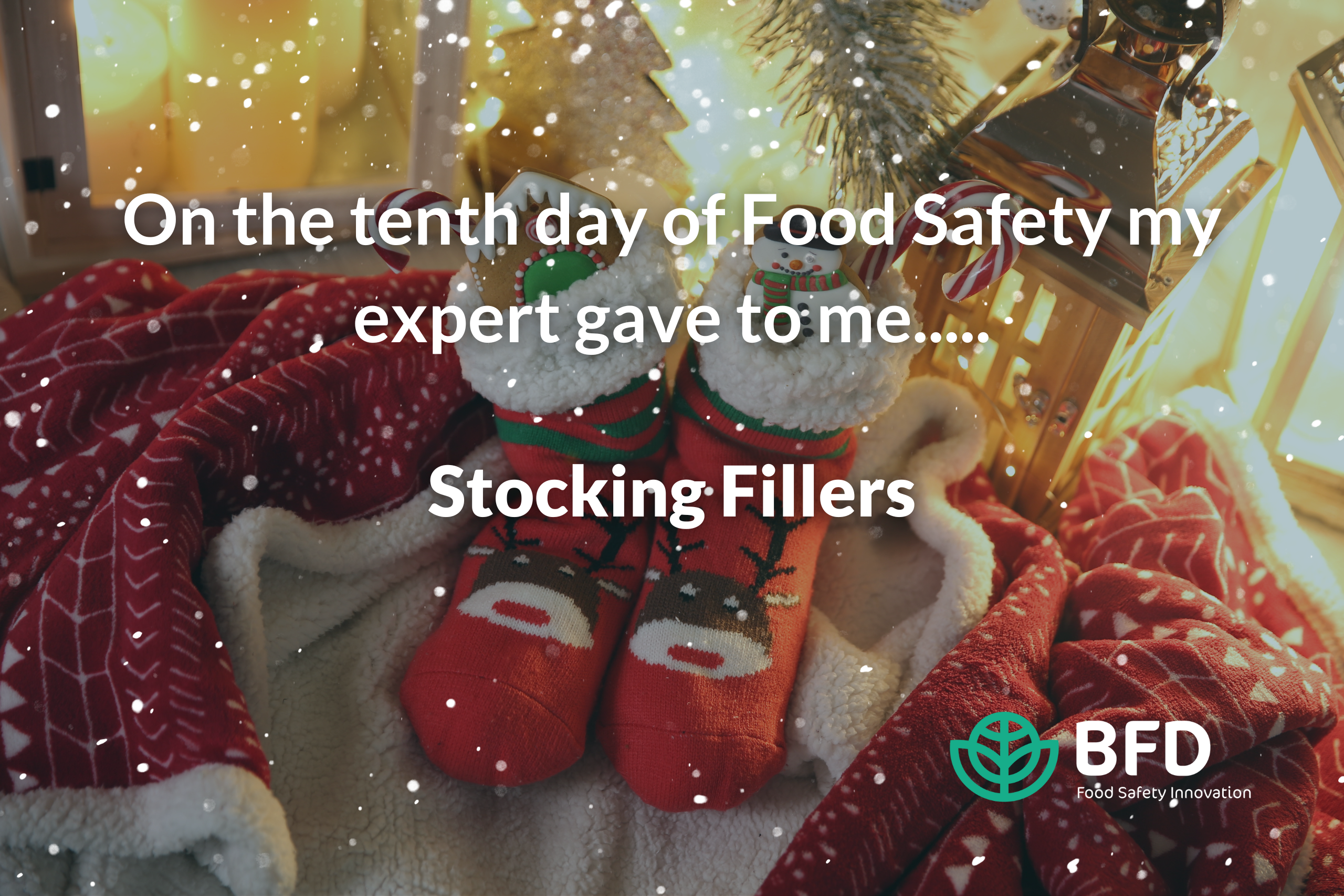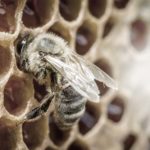
Stocking Fillers: Day 10 – 12 Days of Food Safety
Day 10: Stocking Fillers
12 Days of Food Safety
A stocking filler refers to a small gift or item that is traditionally placed inside a holiday stocking. It’s a small, often inexpensive, and thoughtful present that adds joy and surprise to the holiday tradition. Stocking fillers are delightful, especially when they include tasty treats. Here are some food-related ideas that are perfect for filling up the stockings:
- Chocolate: Small chocolate bars, truffles, chocolate-covered nuts, or festive-shaped chocolates are always a hit.
- Assorted nuts: Packs of mixed nuts, candied nuts, or flavoured nuts can be a savoury tradition.
- Dried fruits: Mini packs of dried fruits like cranberries, apricots, or mango slices are healthy and delicious.
- Popcorn: Gourmet popcorn packets or flavoured popcorn (like caramel or cheese) can be a fun addition.
- Mini jams or honey: Small jars of speciality jams, fruit preserves, or honey can be a sweet addition.
Remember, the key is to ensure that the treats fit into the stocking and that they align with the recipient’s preferences and dietary restrictions, if any. These food items can add a delicious touch to the holiday surprises!
Food Allergens
It is crucial to understand food allergens when selecting gifts or treats for individuals with food allergies. Here’s a list of the common allergens to be cautious of and alternative options 1:
- Nuts: Peanuts and tree nuts like almonds, walnuts, cashews etc are common allergens. Consider nut-free alternative like seeds (sunflower seeds, pumpkin seeds), roasted chickpeas, or snacks explicated labelled as nut-free 1.
- Dairy: Milk and dairy products can be allergens for some individuals. Opt for dairy-free or vegan options such as dark chocolate (dairy-free), coconut milk-based treats, or non-dairy cookies 1.
- Eggs: Some people are allergic to eggs. Look for egg-free baked goods or candies. There are vegan options available that are egg-free and delicious 1.
- Gluten/Wheat: For those with gluten or wheat allergies, choose gluten-free snacks or treats. There’s a wide variety of gluten-free cookies, candies, and snack options 1.
- Soy: Soy can be present in many processed foods. Look for soy-free alternatives or snacks explicitly labelled as soy-free 1.
When gifting food items to someone with known food allergies, it’s essential to carefully read labels and check for potential cross-contamination risks in the production facilities. Products often mention if they are processed in facilities that also handle allergens, which can pose risks to individuals with severe allergies 1.
Both food allergies and food intolerances lead to symptoms after consuming certain foods. Table 1 below highlights that they are distinct conditions with different underlying mechanisms and severity of reactions 2.
| Table 1: Food Allergies vs Food Intolerance 2 | ||
| Food Allergy | Food Intolerance | |
| Bodily Response | The body’s immune system identifies a particular food as harmful, triggering an immune response. This response involves the production of antibodies (IgE) to fight off the perceived threat. | Does not involve the immune system. It occurs when the body has difficulty digesting certain foods of components of foods. This can be due to enzyme deficiencies, sensitivity to food additive, or other reasons. |
| Symptoms | Food allergies can cause a range of symptoms, varying from mild to severe, and even life-threatening reactions such as anaphylaxis. Symptoms can affect multiple systems in the body, including: cardiovascular system, gastrointestinal tract, respiratory system and skin. | Symptoms of food intolerances are generally less severe compared to food allergies. They often involve digestive issues such as bloating, gas, abdominal pain, diarrhoea, or indigestion. |
| Tolerance | Even tiny amounts of the allergen can provoke a significant allergic reaction in individuals with food allergies. Avoidance of the allergen is the primary way to prevent reactions. | Some individuals with food intolerance can consume small amounts of the problematic food without experiencing severe symptoms. Managing the portion size or frequency of intake may help prevent reactions. |
It’s important for individuals experiencing adverse reactions to certain foods to differentiate between food allergies and food intolerances 2. It is also crucial that foods are thoroughly tested in the manufacturing and/or production stage to ensure that precautionary allergen labelling (PAL) is accurate, ensuring that not just intentionally added allergens are documents, but that unintended allergens are documented on PAL too. Due to the absence of clear guidelines means PAL is voluntary, resulting in inconsistencies in how PAL is applied on food labels. This inconsistency can cause confusion for customers, especially those with severe allergies, as they may struggle to interpret PAL statements and make informed choices about the safety of products 3.
Food Allergen Management
Food allergen management is crucial within the food industry to ensure the safety of products for consumers with allergies. Food testing plays a significant role in this process by identifying and quantifying allergens in food products. Here’s how food testing contributes to allergen management 3:
- Allergen identification: Food testing helps in accurately identifying the presence of allergens in food products. Various testing methods such as ELISA, PCR and mass spectrometry can detect specific allergenic proteins, even in trace amounts 3.
- Labelling compliance: Food testing ensures that products are labelled accurately according to allergen regulations. It helps food manufacturers verify the absence or presence of allergens and adhere to labelling requirements, preventing mislabelling or cross-contamination issues 3.
- Quality Control: Testing at different stages of food production ensures that allergen control measures are effective. It helps in monitoring raw materials, production lines, finished products, and cleaning processes to minimise cross-contact and contamination risks 3.
- Risk assessment and management: Analysing the levels of allergens in food products helps assess potential risks for allergic consumers. This information aids in setting threshold levels for allergens and determining safe limits for allergen contamination 3.
- Verification of cleaning procedures: Testing methods help verify the effectiveness of cleaning protocols used to prevent cross-contact between allergenic and non-allergenic products on shared equipment or production lines 3.
- New product development: Food testing is essential when developing new products to ensure all allergens are not introduced unexpectedly during formulation or production processes 3.
- Consumer confidence: Rigorous testing and accurate labelling instil confidence in allergic consumers, enabling them to make informed decisions about the foods they consume 3.
It’s important to note that while food testing is a valuable tool, it should be part of a broader allergen management strategy within the food industry. Good manufacturing practices, proper segregation of allergens, employee training, and thorough cleaning procedures are equally essential in preventing allergen contamination. Additionally, food testing methods continue to evolve, aiming for increased sensitivity, specificity, and speed to meet the demands of the industry and ensure the safety of individuals with food allergies 3.
BFD Allergen Testing Panel
Biorex Food Diagnostics along with our USA partner BioFront Technologies, offer a range of diagnostics to detect the presence of allergens in food products. Our MonoTrace ELISA kits represent the first comprehensive line of monoclonal antibody-based assays aimed at helping the food industry and regulators accurately detect and quantify trace amounts of food allergens in complex matrices. In addition, the kits can be used to assay and surface rinses to rapidly validate removal of potentially allergenic protein residues on food-contact surfaces. MonoTrace ELISAs provide an unmatched union of specificity and sensitivity in food safety testing by incorporating precisely defined sets of monoclonal antibodies optimized to detect major allergens while minimizing cross-reactivity and food matrix interference.
| Description | Cat. Code | Method | Assay Time | LoD | Sample Types |
| Almonds | AP1-EK-96
AP1-EK-48 |
ELISA 96T
ELISA 48T |
30 mins (post extraction) | 0.15ppm | Cake
Cookies Chocolate Spices |
| Brazil Nut | BN-EK-96
BN-EK-48 |
ELISA 96T
ELISA 48T |
30 mins (post extraction) | 0.14ppm | Chocolate
Cookies Ice Cream Cereal Yogurt Milk Flours |
| Cashew | CA2-EK-96
CA2-EK-48 |
ELISA 96T
ELISA 48T |
30 mins (post extraction) | 0.12ppm | Cake
Cookies Chocolate Ice Cream Powdered Infant Soya Formula Yogurt Milk Spices |
| Coconut | CN1-EK-96
CN1-EK-48 |
ELISA 96T
ELISA 48T |
30 mins (post extraction) | 0.12ppm | Cake
Cookies Chocolate Ice Cream Yoghurt Milk Wheat Flour Spices |
| Crustacean | CR1-EK-96
CR1-EK-48 |
ELISA 96T
ELISA 48T |
30 mins (post extraction) | 0.07ppm | Soup Mix
Fish Meat Juices Sauces Condiments Wine Batter Mixes Oil Dressings |
| Egg | EOM-EK-96
EOM-EK-48 |
ELISA 96T
ELISA 48T |
30 mins (post extraction) | 0.56ppm (whole egg) | Flours (wheat, rice, corn)
Salad Dressing Wine Ice Cream Meat Chocolate Cookies |
| Gluten | GLU-EK-96
GLU-EK-48 |
ELISA 96T
ELISA 48T |
30 mins (post extraction) | 0.36ppm (0.18ppm gliadin) | Cereals
Tree Nuts Legumes Seeds Meat Spices |
| Hazelnut | HC9-EK-96
HC9-EK-48 |
ELISA 96T
ELISA 48T |
30 mins (post extraction) | 0.04ppm | Chocolate
Cookies Cake Ice Cream Spices |
| Lupin | LU2-EK-96
LU2-EK-48 |
ELISA 96T
ELISA 48T |
30 mins (post extraction) | 0.13ppm | Flour (wheat, rice, oat, chickpea, lentil)
Chocolate Orange Juice Wine Ketchup Crackers Fruit & Nut Mix Baby Food Raw Meat Red Onion Seasoning Bread/Cake/Cookie Mixes Ice Cream |
| Macadamia Nut | MNI-EK-96
MNI-EK-48 |
ELISA 96T
ELISA 48T |
30 mins (post extraction) | 0.13ppm | Flour
Cake Cereal Cookies Ice Cream Infant Soy Formula Juice Milk Chocolate Spices Wine |
| Milk (Casein) | CAS-EK-96
CAS-EK-98 |
ELISA 96T
ELISA 48T |
30 mins (post extraction) | 0.11ppm casein
0.44ppm non-fat dry milk powder (casein ppm value X 4.13) |
Cake Mix
Corn Flour Rice Flour Infant Soy Formula Non-dairy Chocolate |
| Mustard Seed | MS1-EK-96
MS1-EK-48 |
ELISA 96T
ELISA 48T |
30 mins (post extraction) | 0.13ppm | Soups
Salad Dressings Condiments Cheeses Meat Spices |
| Peanut | PA3-EK-96
PA3-EK-48 |
ELISA 96T
ELISA 48T |
30 mins (post extraction) | 0.24ppm | Infant Forumla
Cake Mix Cereal Chocolate Confectionary Ice Cream Flour Non-Far Dry Milk |
| Pecan | PC4-EK-96
PC4-EK-48 |
ELISA 96T
ELISA 48T |
30 mins (post extraction) | 0.17ppm | Cake Mix
Cookies Flours Chocolate Infant Soy Formula Yoghurt Ice-Cream |
| Pine Nut | PN1-EK-96
PN1-EK-48 |
ELISA 96T
ELISA 48T |
30 mins (post extraction) | 0.24ppm | Cookies
Cake Chocolate Ice Cream Hummus Juice Infant Soy Milk Yoghurt Flour-Chickpea Rice Wine Spices |
| Pistachio | PV1-EK-96
PV1-EK-48 |
ELISA 96T
ELISA 48T |
30 mins (post extraction) | 0.23ppm | Cookies
Cake Chocolate Ice Cream Flour |
| Sesame | SE1-EK-96
SE1-EK-48 |
ELISA 96T
ELISA 48T |
30 mins (post extraction) | 0.16ppm | Cake
Cookies Chocolate (Milk) Ice Cream Flour (Rice, Corn) Cereals Wheat Bread Instant Soup Crackers Meat Spices Milk (including infant formula) Butter |
| Soy | SG6-EK-96
SG6-EK-48 |
ELISA 96T
ELISA 48T |
30 mins (post extraction) | 0.16ppm | Chocolate
Cereal Butter Spices |
| Walnut | WJ4-EK-96
WJ4-EK-48 |
ELISA 96T
ELISA 48T |
30 mins (post extraction) | 0.2ppm | Cereal
Cake Flour Ice Cream Infant Soy Formula Chocolate Cookies |
Have you missed the previous 12 Days of Food Safety? Not to worry. Click the images below to catch up.
References
- Food Standards Agency. Food allergy and intolerance. https://www.food.gov.uk/safety-hygiene/food-allergy-and-intolerance (accessed 18 December 2023).
- Mayo Clinic. Food allergy vs. food intolerance: What’s the difference?. https://www.mayoclinic.org/diseases-conditions/food-allergy/expert-answers/food-allergy/faq-20058538 (accessed 18 December 2023).
- Food Drink Europe. Guidance on Food Allergen Management for Food Manufacturers . chrome-extension://efaidnbmnnnibpcajpcglclefindmkaj/https://www.fooddrinkeurope.eu/wp-content/uploads/2022/04/FoodDrinkEuropes-Guidance-on-Food-Allergen-Management-for-Food-Manufacturers-2022.pdf (accessed 18 December 2023).
















